Steering wheel shakes
Steering wheel shakes — common causes
What causes steering wheel shake when driving?
Steering wheel shake can be caused by a wheel/tire, suspension, drive shaft, or a brake issue. To diagnose the issue you first have to take note of the driving conditions when your steering wheel shakes. For example:
• At what speed does the shaking start and when does it go away?
• Does it happen when you’re braking or when you’re cruising?
• Does it happen only when you’re driving straight, or is it more noticeable when turning
• Were you accelerating, turning, or braking when you notice the steering wheel shake?
• Did you have any work done on your vehicle before you noticed the steering wheel shake?
• Have you hit anything like a curb, speed bump, snowdrift?
• Have you had heavy snow lately or were you stuck in snow or mud?
Once you have that information you can start checking out these most common causes.
Steering wheel shakes when cruising but NOT braking
A tire or wheel issue can cause steering wheel shake when cruising
The most common cause of wheel shake is UNBALANCED TIRES. An unbalanced tire will cause a steering wheel shake that’s most noticeable as you approach 55-MPH and worsens as you reach 60-65-MPH. The shake will decrease as you exceed 65-MPH and will almost completely disappear as you approach 75-80-MPH.
What causes an unbalanced tire?
• Improper balance by the tire shop
• Excessive tire wear (cupping) due to worn shocks.
Shocks and struts are designed to dampen spring oscillations
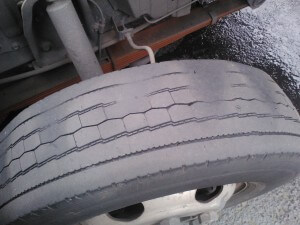
This tire is underinflated (wears on the edges but not in the middle) and cupped due to worn shocks/struts
when going over bumps and potholes. When shocks and struts wear, they fail to dampen the oscillations and the tire continues to bounce. Your tires spend more time in the air and they wear away a small patch of rubber every time they drop back onto the road (think of the burning rubber smoke you see when airplane tires hit the runway). This is called cupping and results in uneven tire weight around the circumference of the tire, which causes even more bounce and steering wheel shake.
• Excessive wear due to an alignment issue can cause steering wheel shake
A vehicle that’s out of alignment causes tires to wear in an uneven pattern. When rubber is worn off one side of the tire, it can’t spin without causing up/down movement and that causes the steering wheel shake. Check tires for even tread wear.
• Missing wheel weights will cause steering wheel shake
All tires need balancing and the shop uses two types of wheel weights to achieve that balance; clip-on wheel weights and adhesive-backed wheel weights. Cold weather can cause adhesive-backed wheel weights to fall off. In addition, plowing through snow or mud can cause both types of wheel weights to fall off. If you steering wheel shake starting after driving through heavy snow or mud, check for a missing wheel weight and have your tires rebalanced.
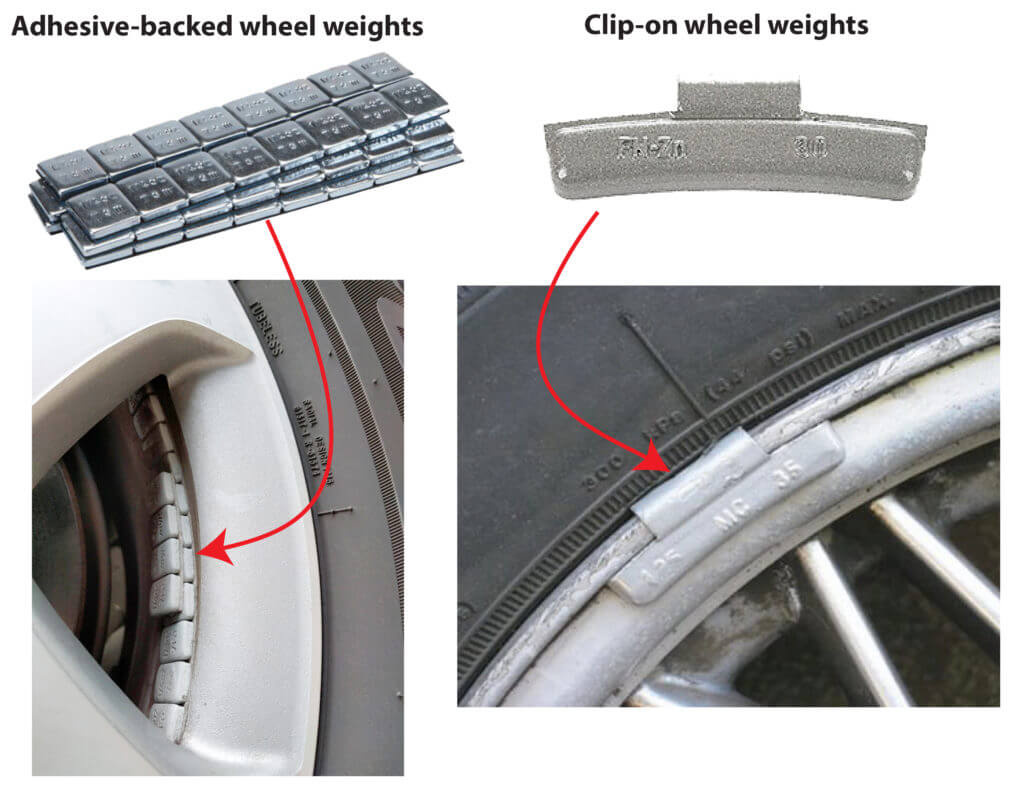
• Snow or mud buildup in the wheel can cause steering wheel shake
If you’ve ever seen the movie My Cousin Vinnie, you know what I’m talking about. If you’ve just driven through heavy snow or mud and now have a steering wheel shake, check for snow or mud pack inside the wheel.
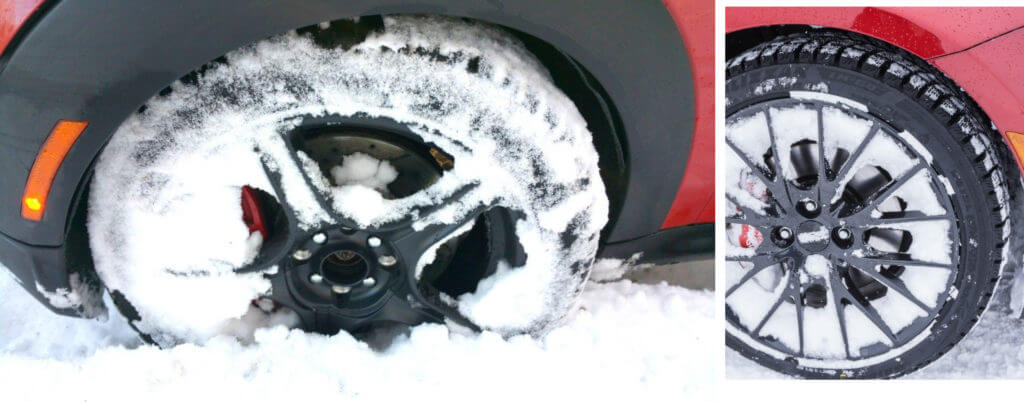
• Bent wheel causes steering wheel shake
Did the steering wheel shake start shortly after hitting a 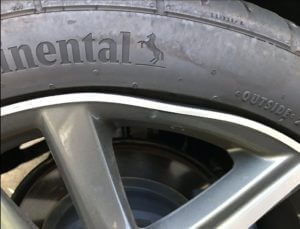 street or parking lot curb stop or debris on the road? If so, you may have bent the wheel. A bent wheel type of shake is usually more noticeable at slow “parking lot” speeds. You’ll notice the steering wheel oscillate left and right at these slow speeds and you may even notice a slight side-to-side “waddle” feeling in the seat of your pants.
street or parking lot curb stop or debris on the road? If so, you may have bent the wheel. A bent wheel type of shake is usually more noticeable at slow “parking lot” speeds. You’ll notice the steering wheel oscillate left and right at these slow speeds and you may even notice a slight side-to-side “waddle” feeling in the seat of your pants.
• Broken belt in tire can cause steering wheel shake
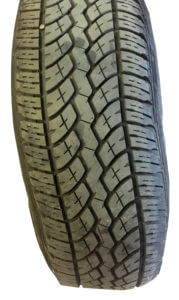
Tire with broken belt
Just like a bent wheel, a broken belt causes a side-to-side steering wheel shake as low speeds. It can also cause side-to-side vehicle movement you can feel in the seat of your pants.
• Underinflated tire(s) can cause shake
Severe underinflation causes the tire tread and sidewall areas to squirm as the tire rotates. This is most noticeable at slower speeds and causes a side-to-side steering wheel shake at speeds less than 30-MPH.
Suspension and steering issues can cause steering wheel shake
• Worn shocks or struts
Shocks and struts are designed to dampen tire bounce after hitting bumps and potholes. When they’re worn out, your tires will continue to bounce after road impacts and that causes noticeable vibration in the steering wheel. If the bouncing occurs in turns, it can also cause the vehicle to wander a bit and cause steering wheel shake.
See this post for more information about shocks and struts
• Worn suspension components can cause steering wheel shake
The wheels on your vehicle mount to a spindle that’s supported by a control arm/lateral link. These supporting members are designed to move up and down and incorporate a rubber bushing to isolate the vehicle from road vibration. Worn rubber bushings introduce a small amount of slop that causes a slight wander. In extreme cases, suspension and steering component wear can cause steering wheel shake.
• Worn wheel bearings cause steering wheel vibration
Wheel bearings keep the wheel in a vertical plane with the vehicle. However, a worn wheel bearing introduces slop that can cause the top of the wheel to move in towards the engine or out towards the curb. In severe cases, the in/out movement can cause side-to-side steering wheel shake. To test for worn wheel bearings, raise the vehicle and try to move the wheel. Grab the wheel at 6:00 and 12:00 o’clock and try to wiggle the wheel in and out. You should not see any movement. Then grab the wheel at 3:00 and 9:00 o’clock and wiggle the wheel left and right. Again, you shouldn’t see any movement.
You can also test for worn wheel bearings during a drive. Find a flat road surface and accelerate to speed. Then make a quick lane change in one direction. Then drive straight and make a lane change in the other direction. If the noise level changes along with a lane change, the noise is most likely caused by a worn wheel bearing. The worn bearing is most likely on the side corresponding to the lane change direction. If you moved to the left lane when you heard the noise change, the problem is most likely the left wheel bearing because the lane change increased the load on the left bearing.
See these posts for more information about wheel bearings.
• Worn tie rod end/ball joints can cause steering wheel shake and vibration
Worn tie rods and ball joints most often cause excessive 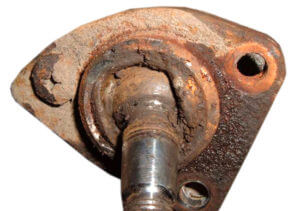 steering wheel play. But in severe cases, they can also cause steering wheel shake. If you notice play in the steering or drifting and inability to keep the vehicle in its lane, have the steering checked out.
steering wheel play. But in severe cases, they can also cause steering wheel shake. If you notice play in the steering or drifting and inability to keep the vehicle in its lane, have the steering checked out.
Steering wheel shakes when braking
A steering wheel shake when braking is almost always caused by brake rotor thickness variation caused by lateral runout.
Rotor lateral runout is caused by
• improper lug nut torque
• rust buildup on the wheel hub
• improper brake pad break-in procedure
• seized brake caliper that prevents brake pad retraction from rotor, causing uneven frictional material buildup on opposite rotor faces.
See this post for more information about brake pedal pulsation that can be felt in the steering wheel.
U-joint and CV joints
U-joints and constant velocity (CV) joints allow a shaft to move up and down and left and right while rotating. If these joints wear, they can cause vibration that can be felt in the steering wheel, especially in tight turns. Worn joints tend to cause steering wheel shake and vibration at low speeds, during heavy acceleration or even when coasting. Test for worn joints by making tight turns as slow speeds in a secluded area of a parking lot. Listen for clicking or clunking noises while doing this maneuver.
It only takes a small amount of play or looseness in any one steering and suspension component to make the whole system noticeably slack. As well as affecting the vehicle’s control and stability, this can also cause steering wheel vibration. It’s therefore important to inspect the system for loose or worn components. Start by checking visible parts like the upper or lower ball joints, tie rod ends and bushings. If you see any signs of damage or excessive play, it is probably faulty and should be replaced. Similarly, loose shock mounts, damaged or detached springs and leaking shocks or struts can cause vibration in the steering wheel. These should be checked and replaced as necessary.
See this post for more information on CV joints
©, 2020 Rick Muscoplat
Posted on by Rick Muscoplat
